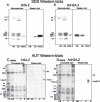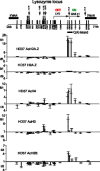The replacement histone H2A.Z in a hyperacetylated form is a feature of active genes in the chicken
- PMID: 16204459
- PMCID: PMC1243646
- DOI: 10.1093/nar/gki874
The replacement histone H2A.Z in a hyperacetylated form is a feature of active genes in the chicken
Abstract
The replacement histone H2A.Z is variously reported as being linked to gene expression and preventing the spread of heterochromatin in yeast, or concentrated at heterochromatin in mammals. To resolve this apparent dichotomy, affinity-purified antibodies against the N-terminal region of H2A.Z, in both a triacetylated and non-acetylated state, are used in native chromatin immmuno-precipitation experiments with mononucleosomes from three chicken cell types. The hyperacetylated species concentrates at the 5' end of active genes, both tissue specific and housekeeping but is absent from inactive genes, while the unacetylated form is absent from both active and inactive genes. A concentration of H2A.Z is also found at insulators under circumstances implying a link to barrier activity but not to enhancer blocking. Although acetylated H2A.Z is widespread throughout the interphase genome, at mitosis its acetylation is erased, the unmodified form remaining. Thus, although H2A.Z may operate as an epigenetic marker for active genes, its N-terminal acetylation does not.
Figures





References
-
- Redon C., Pilch D., Rogakou E., Sedelnikova O., Newrock K., Bonner W. Histone H2A variants H2AX and H2A.Z. Curr. Opin. Genet. Dev. 2002;12:162–169. - PubMed
-
- Santisteban M.S., Kalashnikova T., Smith M.M. Histone H2A.Z regulates transcription and is partially redundant with nucleosome remodeling complexes. Cell. 2000;103:411–422. - PubMed
-
- Meneghini M.D., Wu M., Madhani H.D. Conserved histone variant H2A.Z protects euchromatin from the ectopic spread of silent heterochromatin. Cell. 2003;112:725–736. - PubMed
-
- Dhillon N., Kamakaka R.T. A histone variant, Htz1p, and a Sir1p-like protein, Esc2p, mediate silencing at HMR. Mol. Cell. 2000;6:769–780. - PubMed
-
- Krogan N.J., Keogh M.C., Datta N., Sawa C., Ryan O.W., Ding H., Haw R.A., Pootoolal J., Tong A., Canadien V., et al. A Snf2 family ATPase complex required for recruitment of the histone H2A variant Htz1. Mol. Cell. 2003;12:1565–1576. - PubMed
Publication types
MeSH terms
Substances
Grants and funding
LinkOut - more resources
Full Text Sources
Molecular Biology Databases

